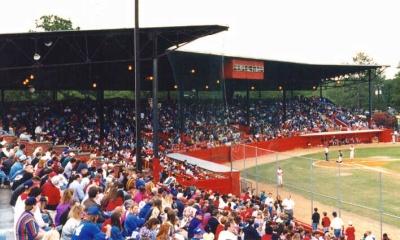
Hardball Capital, owners of our local Minor League Baseball Class A team, the TinCaps, also owns the Savannah Sand Gnats of the South Atlantic League. Â Today, there was an article in Savannah’s local newspaper that talks about Grayson Stadium. Â I will cover that in a moment, but grant me a slight diversion and explanation. Â The reason for my title, you ask? Â One look at the above photo, and I was reminded of the first Fort Wayne ballpark built in what’s now Headwaters Park. Â No, I’m not old enough to have seen it in person, but it has been captured in photographs for posterity. Â That old Fort Wayne ballpark saw Babe Ruth play, who made an incredible claim. Â
The Longest Hit
Babe Ruth came to town in 1927 and smacked, unofficially, the longest home run in the history of the game. Â After citing the official long hits by Babe Ruth, Mickey Mantle and others, Sportswriter Carl Wiegman said: “Ruth hit a longer one in Fort Wayne, according to the Bambino’s version. Â He was on a barn-storming tour after the 1927 season and played a game at League Park on North Clinton Street. Â He belted a ball over the left-centerfield fence and he claimed that the ball landed in a freight car which was passing the park at the time.” Â Wiegman attributes the homer-that-moved-for-miles story to baseball buff Jack Gassert. Â
Yet a person better known the world over than even Babe Ruth once played baseball in Fort Wayne and lived in the city for a season. Â He was Zane Grey whose name is familiar throughout the world in dozens of languages and in more than 100 million books. Â Grey came to the city in 1896 and joined the Summit City entry in the Interstate Pro League. Â
Fresh out of the University of Pennsylvania, Grey had not yet started his career as a writer of western novels. Â He was a 23-year-old outfielder and a native of Zanesville, Ohio, and had been a noted college athlete in several sports. Â He was no slouch in Fort Wayne during that one season and was the leading hitter in the league, batting .374.Â
– Ankenbruck, John. Â Twentieth Century History of Fort Wayne. Â Twentieth Century Historical Fort Wayne, Inc., 1975.
Incidentally, that stadium was burned down on July 12th 1930 by a disgruntled fan who was later caught and prosecuted. Â
Back to the reason for this post, an article in today’s Savannah Morning News reveals some plans are in the works for the 80 year old stadium.
[…] So, the question was asked about the future beyond two years of Grayson and its main tenant.
“Nothing is forever, but this has been here for 80 years, so it’s getting close,” Freier said. “We assess every situation not just on a year-to-year basis. We understand there’s a lot we need to know before we make big decisions.”
Freier said that Hardball Capital intends to be the owners 15 years from now, but a new stadium isn’t a definite conclusion. Instead, the group is studying the possibilities of improving Grayson with a blend of old and new.
“What you have here is a pretty unique stadium,” Freier said. “We’d like to sort of keep that aesthetic and not have elements within the stadium that sort of clash with that sort of thing.”
Time for a makeover
The city had designated $5 million in stadium renovations through the Special Purpose Local Option Sales Tax (SPLOST) before Atlanta-based Hardball Capital arrived. About $2 million was spent on new sod, irrigation and drainage systems as well as light poles last offseason, leaving about $3 million more for improvements. Freier and city officials said they are working together on what to do next.
[…] A brief look at how Hardball Capital approached similar scenarios could be instructive. Freier said that in Fort Wayne, the existing stadium – despite being 15 years old – had so many problems that instead of throwing money at repairs, “the smarter investment was the new ballpark.”
When Hardball owned a ballclub in Salem, Va., the ballpark needed improvement, but it was “much more efficient, much more bang for your buck, building on what was a great foundation.
“Grayson is so much harder to assess than any of those others because you have the history factor, which is important. You also have a lot of difficulties here that are not things we have not encountered in other ballparks.”
He pointed to Grayson’s grandstand, running his finger from third to first base, and said architects and construction experts had said that changing the concourse and the clubhouse would run into $10 million to $20 million, much more than $3 million from SPLOST could cover.
Credit to What’s Going Down(Town) and Scott Spaulding for first sharing the aricle.